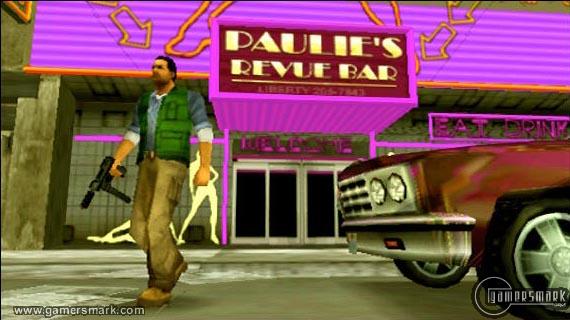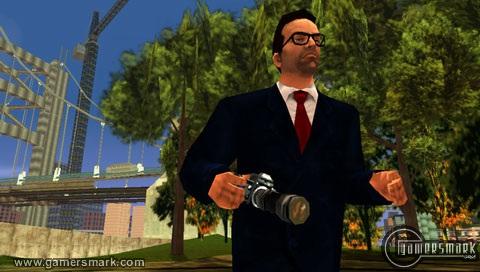Developer: Rockstar Leeds / Publisher: Rockstar Games || Overall: 9.5/10
Grand Theft Auto has finally made its way to a portable system in pure 3D. Only possible by taking advantage of the Playstation Portable’s technology, Grand Theft Auto: Liberty City Stories is an amazing transition of this generation’s Grand Theft Auto games from console to handheld. Regarded as the first major release on the PSP, Liberty City Stories is a major reason for owning the pricey handheld.
Taking place in Liberty City, the same city as in Grand Theft Auto III, you take the role of Toni Cipriani. For Grand Theft Auto III patrons, you’ll remember Toni Cipriani from nearer to the beginning of the game that had the mom who’d yell through the window during the cutscenes where you would take missions from Toni. Being part of Salvatore Leone’s gang, Toni will visit many familiar places and will see familiar faces that you will instantly recognize from GTA III. But, since Liberty City Stories is a prequel to Grand Theft Auto III, all the events that had actually taken place in Liberty City during GTA III haven’t actually happened yet. As such, certain buildings will be under construction to reflect that Liberty City Stories is a prequel. Not to mention certain people still being alive. However, Liberty City is still intact just as it was played on the Playstation 2, but there are enough changes and shake-ups to the city that will make Liberty City Stories unique.
The most important thing to mention about the game is the controls. Unfortunately for the PSP, it just doesn’t have as many buttons or analog sticks as the Dual Shock controllers do. But the hardware limitations don’t stop the game from having good enough controls to make those limitations almost not be a factor. Almost. There are two pre-set configurations in the Controls menu which will change the functions of the shoulder buttons for car use. SETUP1 will make L the “Look” button, that when pressed you move the analog stick the direction you want to look at while driving, and the R button the hand brake. SETUP2 will give a closer feel to the controls of the console games, making the shoulder buttons look left, right, or behind when both are pressed. There are no differences between the setups for when you’re on foot. There is also the option to change how you control the character – either with the analog stick or the directional buttons. Whatever movement selection is not used for primary movement, it will become less important, yet necessary, controls such as honking the horn, starting a special mission, radio station cycle, weapon cycle, and target cycle. Since the analog stick on the PSP is just about at a perfect sensitivity for moving and driving around, it’s more beneficial to use the directional pad as the other functions. But any way you slice it, the only real problem you might have is when it comes to shooting and targeting with weapons. When you get into instances where there is a requirement for high-speed shooting and targeting action, the PSP’s controls are not as responsive as a Dual Shock controller’s and you may get frustrated having to try something over and over again.
Plenty of the aspects of the Grand Theft Auto games actually work well for the handheld arena. Mostly the Taxi, Ambulance, and Vigilante missions, as well as a few other special non-story missions can easily be initiated and completed within a very short amount of time. Even story missions are finer tuned and shorter to complete. Another big point to the formula is the loading times. The only time you’ll see noticeable loading times are when you first start up the game, move around to other parts of Liberty City (which are the same as Grand Theft Auto III), and right before missions. While it could get annoying when you constantly retry the same mission, the loading times are very acceptable in the end and typically don’t take out a chunk of your playing time. There is also a slight lag between switching radio stations as the audio loads, but nothing too out of the ordinary. As a consequence the UMD will be spinning most of the time, since the data will stream off, resulting in less actual playtime unless you’ve got an outlet nearby.
As for graphics and sound, they’re exactly what is to be expected from the series. Not only that, it is truly amazing how they could pack it all in into such a small package. Compared to GTA III, the game looks to be on the same level, if not better. The cars look realistic, as well as the damage to the cars. Buildings themselves also look exactly how they should be remembered. The most impressive thing about it all is that the actual distance that you can see is a whole lot better than what had been done in almost any other GTA game. You might also notice a little bit of ghosting and frame rate, which is very solid, can drop at points. Radio stations are just as diverse as they were in GTA III, not to mention a couple more were added, along with the ability to play custom tracks off your memory stick. To utilize the custom tracks, however, you have to download a free program to your computer that will convert CDs into a format that the game can read – MP3s can’t be directly used. Voice work is also nothing short of what is to be expected. All the voice actors that played reoccurring characters from the series have reprised their roles, and while it may sound a little tinny at times, there really isn’t anything to complain about in that regard.
Besides a little bit of a shake-up in the control scheme, everything about the game gives the same experience of its console brethren. There’s a great story in a huge city filled with tons of things to do for everyone, even veterans of the series that will spark enjoyment on some level, and you can take it anywhere you want. Grand Theft Auto: Liberty City Stories is by far the best game you can spend your money on at this point in the PSP’s life.



